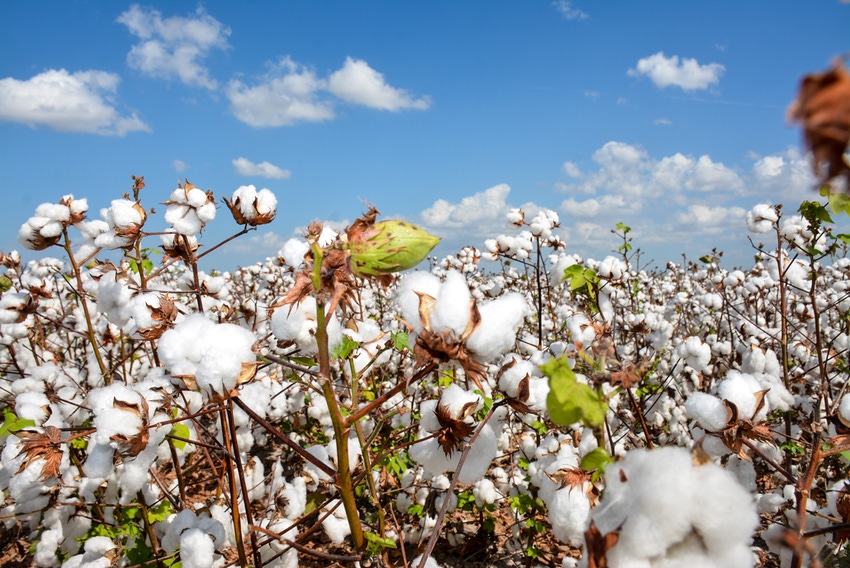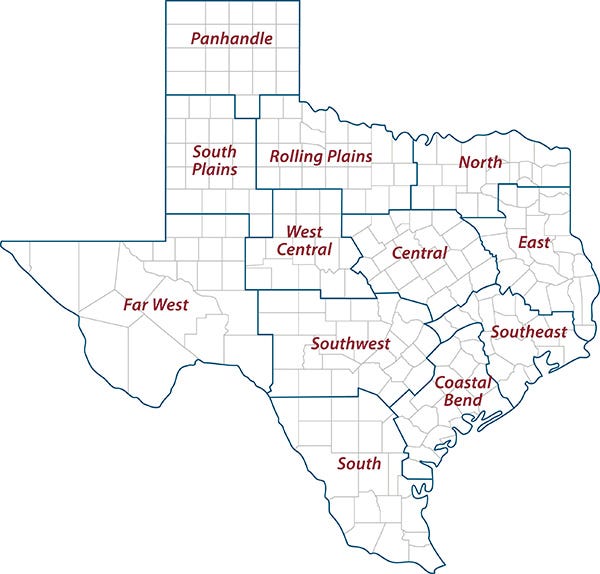
Texas cotton farmers whose fields survived inhospitable weather conditions early in the season are hoping for a market rally, but a Texas A&M AgriLife Extension Service expert said price speculation at this point is risky.
Dr. John Robinson, AgriLife Extension economist, College Station, said cotton acreage is down due to weather delays or unfavorable conditions for the crop’s emergence in many parts of the state. But it’s still unclear, from a market perspective, how a reduction of cotton acres will affect prices long-term.
Other cotton producing states experienced similar weather conditions that reduced crop acreage, he said.
The June 28-U.S. Department of Agriculture National Agricultural Statistics Service acreage report estimated 13.7 million acres of cotton to be planted, 3 percent less than last year.
“I’m hearing a lot of different voices saying the report isn’t accurate and that they believe the actual acreage number is much lower,” he said. “And I agree that the report is not as reliable as it usually is, but there is a lot of uncertainty that muddles up the big picture. In the end, I think that tempers any speculation on where the market will be when we get certified acres data from USDA.”
Even if the crop is down several hundred thousand acres more, Robinson said expectation of a short crop and higher prices could be premature due to good moisture profiles and newer cotton variety characteristics.
“Sure, acres might be down, but it’s still difficult to speculate,” he said. “What if the acres that are planted produce record yields because of good moisture this summer and ideal maturation conditions in September and October? Given that possibility, I’d be hesitant to bet on extreme price volatility at this point.”
Producers who have cotton in the ground are hopeful for better prices than they are getting now, which are below profitability based on AgriLife Extension crop calculations.
Cotton futures have settled to the mid-60-cent-per-pound range since May compared to around 80-cents per pound last fall, he said. Most farmers need cash prices to be in the 70s to cover their input costs.
Robinson said another major factor in the cotton market – resolution to the trade dispute with China – could happen unexpectedly. An agreement would likely mean a price rally despite reductions in U.S. cotton exports to China over recent years.
“China used to be the top destination for U.S. cotton, but we’ve lost market share to Brazil, and that’s thrown a wet blanket on export sales,” he said. “It’s encouraged other international buyers to negotiate better terms with U.S. merchants, which translates to lower cash offers for U.S. producers.”
Robinson said he expects cotton to remain around the mid- to upper 60-cents per pound for the foreseeable future unless an agreement with China is reached. That leaves cotton farmers with a healthy crop guessing about potential prices at harvest or contracting at currently lower prices to cut their losses.
“It’s a tough spot to be in,” he said. “They want an opportunity for a higher price, and bullish factors could deliver. But they also might wait for prices to go to 78 (cents per pound), and they may never get there.”
AgriLife Extension district reporters compiled the following summaries:

CENTRAL: Some areas received more than 2.5 inches of rain. Temperatures were normal. Bermudagrass stem maggots and grasshoppers were reported in many fields. Several dry days in the forecast should allow producers to access fields and get some work done. Corn looked good with fields in milk, dough and dent stages, depending on location. Grain sorghum stages ranged from pollinating to pre-boot. Sugarcane aphids were present, but well below the economic threshold. Pastures were looking good as well. Sheep prices were up, and cattle prices were steady. Crops were experiencing light insect pressure. Growing conditions were good with moisture available and sunshine. Hay production was in full swing after a slow start due to excessive moisture. Cotton was progressing nicely. Nearly all counties reported adequate soil moisture. Overall rangeland, pasture and crop conditions were good.
ROLLING PLAINS: The district had another warm, windy week. Cotton producers completed planting. Some producers may replant with alternate crops due to recent weather-related events. Wheat harvest was coming along with some areas finishing up. Yields were above average. Most pastures were in great condition for this time of the year. Horn fly populations were increasing in cow herds, and many producers were utilizing control practices.
COASTAL BEND: Scattered showers were reported in some areas. Rains slowed the start of grain harvest a little. Harvests of both corn and grain sorghum were beginning. Most corn was drying out and at the dough stage. Producers were busy applying harvest aid to grain fields. Yields looked strong by all reports. Cotton was blooming and setting bolls and could benefit from another good rain. Cotton farmers were actively scouting and spraying for aphids, stinkbugs and bollworms. Rice was doing well and starting to head. Hay pastures were being cut and baled as weather allowed. Hay was plentiful and, as a result, little has sold. Livestock were in excellent condition.
EAST: As much as 4 inches of rain fell across the district, causing more problems for hay producers. Pastures were too wet for cutting or baling. Anderson County reported a total loss of corn fields. No cotton was planted due to flooding. Jasper County reported peas experienced a setback for unknown reasons that caused pods in multiple fields to not mature. Pastures and rangelands were good despite weather conditions. Subsoil and topsoil remained adequate. Grass was growing well and greening up, providing good grazing. Ponds and creeks were full. The Trinity River was back at flood stage. Temperatures were warmer. Cattle were fat and calves grew well. Wild pigs caused a lot of damage in several areas. Horn fly numbers continued to increase. Houston County producers were concerned conditions were ripening for armyworm infestations.
SOUTH PLAINS: Subsoil and topsoil moisture levels were still good to adequate in some areas. Lack of rainfall was becoming a concern in some areas. Producers seemed to be done replanting where they were flooded out. Cotton looked good in some counties and in varying stages. Weed pressure increased, and irrigation systems were used to supplement the lack of natural precipitation. Grasshoppers were becoming a problem for crops and rangelands. Pasture, rangeland and winter wheat conditions were good. Cattle were in good condition.
PANHANDLE: Cool, wet spring weather produced good dryland wheat. Yield estimates averaged 20-80 bushels per acre with some irrigated fields pushing the 100-bushel mark. However, 40-60 percent % of cotton acres were losses. Producers ran pivots hard and fast on corn fields as rainfall stopped and temperatures pushed back to the 100-degree mark. Heat and wind zapped moisture from the soil profile. Cattle and pasture conditions were excellent but could begin to decline without rain.
NORTH: Soil moisture was mostly adequate to surplus across the district. Heavy rains fell across most of the district with counties reporting 1.5-3 inches. Daytime temperatures were in the upper 80s to low 90s. Hay producers were busy cutting and baling. The warm-season pastures looked good, especially the Coastal Bermuda grass. The oat harvest was complete with average yield around 80 bushels per acre. The wheat harvest was nearing completion, and yields were way above average at 70 bushels per acre and weights about normal at 60 pounds per acre. Corn harvest was right around the corner; fields looked good with minimal damage from insects and earworms. Sorghum looked OK with most fields in the boot to heading stages. Soybeans fields looked good, and yields should be above average. Some farmers were expected to plant late soybeans behind wheat. Cattle looked great with all the excess forage this spring. A lot of stockers were shipped to the feed yards the last couple weeks, and the weights and average daily gains were good. Cow-calf operations finished working their cattle and were set for the summer. Most were done weaning and shipping their fall calves, and breeding season was over or almost over for most operations.
FAR WEST: Temperatures averaged highs in the low 100s and lows in the mid-60s. Trace amounts of rain were recorded. Cotton finally started to grow in most parts of the district. Several fields showed mixed maturity with 2-leaf and 5-6-leaf cotton in the same field. Most cotton made a good stand. A few producers replanted up to four times. Grains looked good, and most missed higher temperatures during pollination. Pecan and fruit trees needed irrigation. Grasses were showing signs of stress due to heat and lack of rainfall. Livestock and rangeland conditions were fair. Producers continued to feed wildlife and livestock.
WEST CENTRAL: Evening thunderstorms were common across parts of the district. The continuous rains were keeping the soil moisture profile in good shape but were presenting a challenge to hay producers. Many were hesitant to cut for fear of having it rained on. Haygrazer fields continued to need cutting. Yields and quality looked above average. Stock tanks were full, and all classes of livestock remained in mostly good condition. Sheep and goat producers, especially on small acreage, continued to battle internal parasites. The pecan crop was progressing well. Cattle prices remained steady.
SOUTHEAST: Rains were scattered across the district with parts of Lee County reporting up to 1 inch of rainfall. Grimes County reported that parts were saturated by rain while other areas were dry. More rain was in the forecast. Hay harvest and post-harvest fertilization was active as weather allowed. Vegetable gardens looked good, but many plantings were declining due to summer heat. In Jefferson County, the early rice was headed. Rice disease was found, and more was expected due to rainy, humid weather. Rangeland and pasture ratings were poor to excellent with good being most common. Soil-moisture levels ranged from adequate to surplus with adequate being most common.
SOUTHWEST: Counties received rain amounts from 0.30-4 inches. The rain was needed but made hay harvest difficult to impossible for some producers. Rangelands and pastures were lush. Corn, sorghum and cotton benefited from rains. Livestock and wildlife were in good condition.
SOUTH: Northern parts of the district reported warm weather conditions with adequate soil moisture levels. Eastern and western parts of the district reported hot weather with rainfall and short to adequate soil moisture levels. Wet weather conditions were reported in the southernmost part of the district, but soil moisture levels remained short. Kleberg and Kennedy counties received 1 inch on average. Starr County reported up to 2.5 inches of rain with flooding in some areas. Willacy County reported parts of the county west of U.S. Highway 77 received 12-18 inches of rain for the reporting period. Up to 4 inches of rain was reported east of U.S. Highway 77. Potato harvest was completed, and peanut planting was coming to an end. Watermelons and cantaloupes were at the peak of summer production. Cotton, corn and sorghum made good progress, and producers did not report any insect pressure. Corn was drying up, and cotton was in full bloom. Grain sorghum was nearing harvest in Jim Wells County. Bermuda grass was cut and baled for hay. Irrigated Coastal Bermuda grass irrigated fields were producing high volumes of hay bales. Pasture and rangeland conditions were good in most areas due to recent rainfalls. McMullen County reported spotty but significant rains helped improve rangeland conditions. Cattle had adequate forage, and body conditions were good. Producers in Zapata County reported declining pasture and rangeland conditions and were feeding cubes and hay. Pecans made good progress following irrigation water applications.
Source: is AgriLife TODAY, which is solely responsible for the information provided and is wholly owned by the source. Informa Business Media and all its subsidiaries are not responsible for any of the content contained in this information asset.
About the Author(s)
You May Also Like




